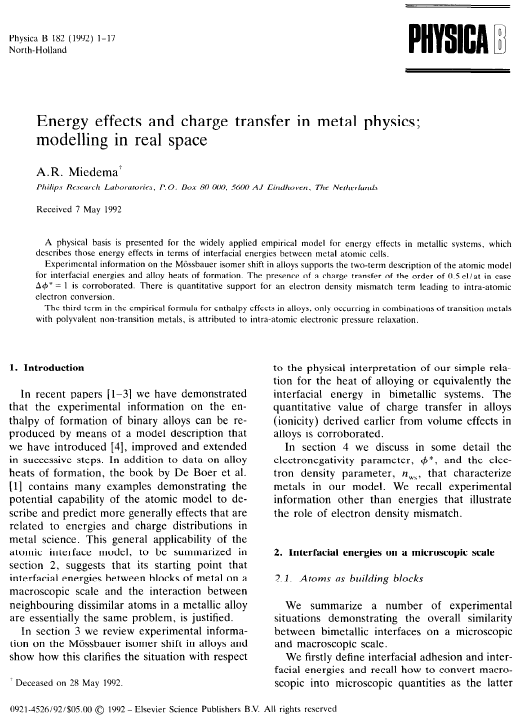Saddest article of all..
August 7, 2008 Posted by Emre S. Tasci
Still saddened by the loss of Randy Pausch whom I knew about from his famous "Last Lecture", while working on the Miedema’s Model, I came across this article by him:

Dr. Villars had already mentioned Miedema’s passing at a young age but still it was really tragic to find such a sad detail on a scientific article.
I checked the web for a Miedema biography but couldn’t find any. The only information I could find was from H. Bakker’s book which I’m quoting the preface below:
PREFACE
Andries Miedema started developing his rather unconventional model in the sixties as a professor at the University of Amsterdam and continued this work from 1971 at Philips Research Laboratories. At first he encountered scepticism in these environments, where scientists were expecting all solutions from quantum- mechanics. Of course, Miedema did not deny that eventually quantum mechanics could produce (almost) exact solutions of problems in solid-state physics and materials science, but the all-day reality he experienced was, – and still is -, that most practical problems that are encountered by researchers are too complex to allow a solution by application of the Schr6dinger equation. Besides, he believed in simplicity of nature in that sense that elements could be characterised by only a few fundamental quantities, whereby it should be possible to describe alloying behaviour. On the basis of a comparison of his estimates of the heat of formation of intermetallic compounds with ample experimental data, he was gradually able to overcome the scepticism of his colleagues and succeeded in convincing the scientific world that his model made sense. This recognition became distinct by the award of the Hewlett Packard prize in 1980 and the Hume-Rothery decoration in 1981. At that time, Miedema himself and many others were successfully using and extending the model to various questions, of course realising that the numbers obtained by the model have the character of estimates, but estimates that could not be obtained in a different fast way. It opened new perspectives in materials science. Maybe the power of the model is best illustrated by a discussion, the present author had with Jim Davenport at Brookhaven National Laboratory in 1987. Dr Davenport showed him a result that was obtained by a one-month run on a Gray 1 supercomputer. This numerical result turned out to be only a few kilo Joules different from the outcome by Miedema’s model, obtained within a few minutes by use of a pocket calculator. Andries Miedema passed away in 1992 at a much too young age of 59 years. His death came as a bad shock not only for the scientific community in The Netherlands, but for scientists all over the world. However, for his family, friends and all the people, who knew him well, it is at least some consolation that he lives on by his model, which is being used widely and which is now part of many student programmes in physics, chemistry and materials science.
It is the aim of the present review to make the reader familiar with the application of the model, rather than to go in-depth into the details of the underlying concepts. After studying the text, the reader should be able, with the aid of a number of tables from Miedema’s papers and his book, given in the appendix, to make estimates of desired quantities and maybe even to extend the model to problems that, so far, were not handled by others. Beside, the reader should be aware of the fact that not all applications could be given in this review. For obvious reasons only part of all existing applications are reported and the reader will find further results of using the model in Miedema’s and co-worker’s papers, book and in literature.
Dr Hans Bakker is an associate professor at the Van der Waals-Zeeman Institute of the University of Amsterdam. In 1970 Andries Miedema was the second supervisor of his thesis on tracer diffusion. He inspired him to subsequent work on diffusion and defects in VIII-IIIA compounds at a time, when, – as Bakker’s talk was recently introduced at a conference -, these materials were not yet relevant’ as they are now. Was it again a foreseeing view of Andries Miedema? Was it not Miedema’s standpoint that intermetallic compounds would become important in the future?
Rather sceptic about the model as Bakker was at first like his colleagues, his scepticism passed into enthusiasm, when he began using the model with success in many research problems. In 1984 Bakker’s group started as one of the first in the world ball milling experiments. Surprisingly this seemingly crude technique turned out to be able to induce well-defined, non-equilibrium states and transformations in solids. Miedema’s model appeared again to be very helpful in understanding and predicting those phenomena.
Hans Bakker
Mauro Magini
Preface from Enthalpies in Alloys : Miedema’s Semi-Emprical Model
H. Bakker
Trans Tech Publications 1998 USA
ISSN 1422-3597



Leave a Reply